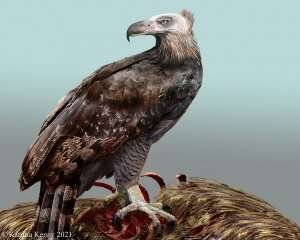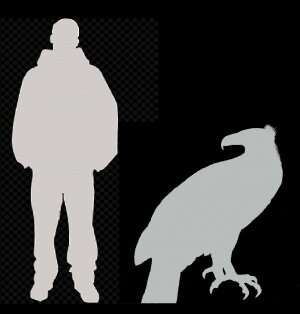Artist's impression of Haast's Eagle. Credit: Katrina Kenny
New Zealand's extinct Haast's eagle (Hieraaetus moorei), the largest known eagle, gulped down viscera like a vulture and may even have been bald, new research suggests.
An international team of researchers including Canterbury Museum Senior Curator Natural History Dr. Paul Scofield, compared the skull, beak and talons of Haast's eagle held in Canterbury Museum with those of five living meat-eating birds to learn about the extinct raptor's feeding habits.
Dr. Paul Scofield says the new research, published today in the peer-reviewed journal Proceedings of the Royal Society B, has given us a much clearer picture of how Haast's eagle fed.
"Most eagles hunt prey that is smaller than them, but Haast's eagle was going after moa that could weigh up to 200 kg—more than 13 times their own body weight. Condors also often eat animals that are much larger than them, so it makes sense that they'd have similar feeding habits.
As a result of this research, when we picture a Haast's eagle feeding we can imagine them swooping down on a moa, grabbing on with those huge talons and using its powerful beak to deliver the killing blow. Once the moa was down, the eagle would go straight for the back of the skull and for the guts and other soft organs."
The study found that the beak and talons of Haast's eagle were eagle-like. However, the shape of its neurocranium—the section of skull that encloses the brain, and a key indicator of feeding behavior in birds—was most like that of the Andean Condor, a South American vulture.
Haast’s Eagle compared to the size of an average man. Credit: Steve Wroe
The Condor is a gulper, a bird that feeds on the soft internal organs of a carcass. Its similarities to the Haast's eagle suggest the giant eagle probably also feasted on the guts and other internal organs of its prey.
If Haast's eagle ate like a Condor, its head and neck might also have been featherless like that of the Condor and most other vultures.
This theory is supported by a Māori drawing thought to depict a Pouākai or Haast's eagle in the Cave of the Eagle at Craigmore Station in South Canterbury. In the drawing, the eagle's body is colored black but its head and neck are uncoloured.
Since Haast's eagle was formally described by Julius von Haast in 1872, scientists have debated whether it was a predator that killed other animals for food or a scavenger that ate animals that had already died.
In recent years consensus has shifted towards the eagle being a predator—one that evolved to hunt the large flightless moa that roamed Aotearoa New Zealand before humans arrived.
This new research supports the predator theory. Haast's eagle talons were similar to those of today's eagles, in particular Australia's Wedge-tailed eagle, although they were much larger and more powerful. These similarities suggest that, like other eagles, Haast's eagle used its talons to hunt.
Note: The moa became extinct between 1400 and 1500 AD.
More information: A. H. van Heteren et al, New Zealand's extinct giant raptor ( Hieraaetus moorei ) killed like an eagle, ate like a condor, Proceedings of the Royal Society B: Biological Sciences (2021). DOI: 10.1098/rspb.2021.1913
Journal information: Proceedings of the Royal Society B
Provided by Canterbury Museum






















